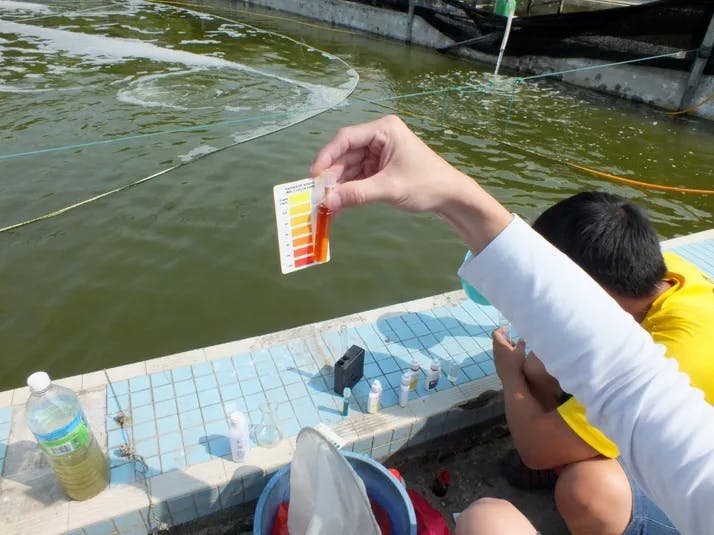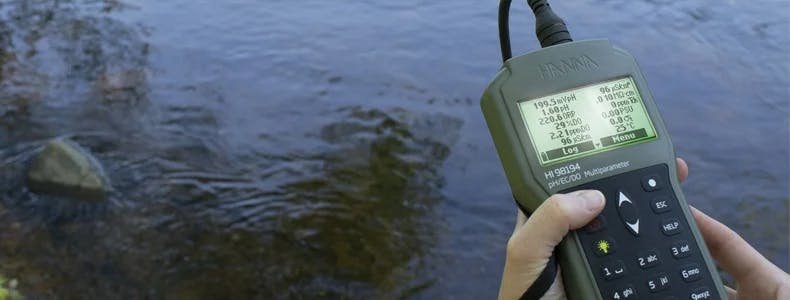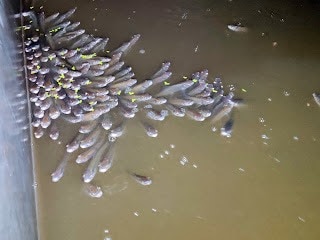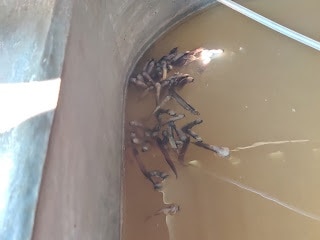Main water quality parameters in BFT
Water quality maintenance and monitoring in any aquaculture are the essential practices aiming at the success of the growing cycles. Temperature, dissolved oxygen (DO), pH, salinity (EC), ORP, solids [total suspended solids (TSS) and settling solids], alkalinity, and orthophosphate are some examples of parameters that should be continuously monitored, especially in BFT. The comprehension and understanding of water quality parameters and its interactions in BFT are crucial to the correct development and maintenance of the production cycle. For example, safety ranges of pH, DO, EC, total ammonia nitrogen (TAN), solids, and alkalinity will lead a healthy growth and avoid mortalities.
PH Level
pH is a measure of whether water is acidic or basic. Fish have an average blood pH of 7.4, so pond water with a pH close to this is optimum. An acceptable range would be 6.5 to 9.0. Fish can become stressed in water with a pH ranging from 4.0 to 6.5 and 9.0 to 11.0. Fish growth is limited in water pH less than 6.5, and reproduction ceases and fry can die at pH less than 5.0. Death is almost certain at a pH of less than 4.0 or greater than 11.0. In BFT water pH fluctuates throughout the day. Typically, pH is highest at dusk and lowest at dawn. This is because nighttime respiration increases carbon dioxide concentrations that interact with water producing carbonic acid and lowering pH. This can limit the ability of fish blood to carry oxygen.

Alkalinity is water's ability to resist changes in pH and is a measure of the total concentration of bases in pond water including carbonates, bicarbonates, hydroxides, phosphates and borates. These bases react with and neutralize acids, buffering changes in pH. Carbonates and bicarbonates are the most common and important components of alkalinity. A total alkalinity of at least 20 ppm is necessary for good pond productivity. Water with high alkalinity and similar hardness levels has a neutral or slightly basic pH and does not fluctuate widely.
ORP
It’s an acronym for Oxidation-Reduction Potential (or Redox Potential in some parts of the world). Essentially, ORP is a measurement of water’s cleanliness as a function of the pollution or contaminants in it. The pollution, known as dissolved Organic Compounds (or DOCs), is too small and fine to be removed from the water by traditional mechanical filtration.

The number given by an ORP (ORP stands for Oxidation Reduction Potential) meter is a direct index to the pollution levels of the pond. Unlike most of our other water quality readings, lower numbers are bad, while higher numbers are good. Readings below 150 indicate a pond in need of significant improvements. 250-400 is the range of healthy ponds, and conditions which promote good fish growth. High numbers between 475 and 550 reflect active Potassium Permanganate use, which should kill parasites.
ORP reading can help you determine if your filtration is working properly or if you need more filtration. At readings of below 150, significant improvements to the filtration of the pond should be made as soon as possible to avoid massive fish health problems. At readings between 150 to 200, fish health will not be marginal, with green water and slime algae a usual occurrence, especially in the absence of UV lights.At readings between 200 to 250, fish health will usually be okay, but not optimum, and stringy algae or blanket weed will normally be a problem.Readings between 250 and 400 reflect good to superb water quality, and prevention of fish health problems by water excellent water quality control. The higher end of this range is preferred over the lower end for dependably good fish health and fast fish growth.
EC (Electrical Conductivity)
EC or Electrical Conductivity of water is its ability to conduct an electric current. Salts or other chemicals that dissolve in water can break down into positively and negatively charged ions. These free ions in the water conduct electricity, so the water's electrical conductivity depends on the concentration of ions. Salinity and total dissolved solids (TDS) are used to calculate the EC of water, which helps to indicate the water’s purity. The purer the water the lower the conductivity.

Major positively charged ions that affect the conductivity of water are sodium, calcium, potassium and magnesium. Major negatively charged ions are chloride, sulfate, carbonate and bicarbonate. Nitrates and phosphates are minor contributors to conductivity, but they are very important biologically. The natural impacts on EC in water are rain, geology, and evaporation. Human impacts include road salt, septic/landfill leachate, impervious surface runoff, and agricultural runoff.
When water is subject to pollution, contamination, or impurities, we will see a change in the EC of that water as the dissolved substances increase the level of EC. As such, EC can be a good indicator of pollution in water. It is worth noting, however, that impurities such as salt in seawater for example, cause very high EC readings as the water contains a large amount of dissolved salt. This is because when salt is dissolved, it separates into ions (electrically charged atoms).
Conductivity is usually measured in microSiemens (µS/cm) and readings generally fall between 30 µS/cm to 2000 µS/cm. Seawater, for example, will have a reading of approximately 50, 000 µS/cm. An interesting fact worth mentioning is that conductivity will actually increase when the temperature of the water increases, hence EC is commonly recorded at a 25°C with temperature and EC being recorded simultaneously. Another unit of measurement for EC is mS/cm or milliSiemens per centimeter. 1 mS/cm = 1000 µS/cm and you will often find measurements displayed as mS/cm for higher levels of EC (i.e. 2000 µS/cm or more).
TDS
Total Dissolved Solids (TDS) refers to the amount of substances that have been dissolved in the liquid. These substances can include salts, minerals, metals, calciums and other compounds which can be both organic and inorganic. In simple terms, TDS refers to anything present in the water that is not pure water and is not a suspended solid. The most commonly used method of determining TDS is measuring specific conductivity to detect the presence of ions in water (EC). Once the EC is determined, a conversion factor is ran (generally by the meter performing the measurement) to determine the TDS. The conversion factor will differ depending on the sample you are testing, conversion factors generally range from 0.4 – 1.0. This method, however, only estimates TDS levels.
TDS is generally measured in parts per million (ppm) but can also be measured in mg/L. Generally, good quality water will fall between 0 and 600 ppm and readings over 1200 ppm is often considered an unsatisfactory level of TDS.
Temperature
Water temperature is the most important factor for the fish growth and it affects all metabolic and physiological activities of fish and plankton. Water temperature plays an important role in influencing the periodicity, occurrence and abundance of phytoplankton as it had a direct relationship with total plankton (Tripathi and Pandey, 1990; Mohapatra et al., 2002, 2007, 2009 & 2012) [16, 10, 11, 12, 13]. Fishes are cold-blooded animals and dependent upon the water temperature in which they liveThe temperature of water is an important variable in aquaculture, but in most types of aquaculture it cannot be controlled and depends upon the amount of solar radiation, air temperature, or the temperature of water passing through the culture unit. Aquatic animals are strongly affected by temperature; aquaculture operations must be timed to correspond to water temperature, and temperature measurements are critical for efficient operations.
Temperature is an important factor effecting the growth and survival of all organisms. However, water temperature is especially important to the growth and survival of shrimp, fish, and other aquaculture animals, because they are poikilothermic (coldblooded). Poikilothermic animals cannot control body temperature, and they equilibrate with the temperature of the surrounding water. Aquaculture animals usually are classified as coldwater, warmwater, and tropical species.
Coldwater species will not tolerate temperatures above 20 to 25 degrees-C. Warmwater species will usually not reproduce at temperatures below 20 degrees-C or grow at temperatures below 10 to 15 degrees-C, but they survive much lower winter temperatures. Tropical species will die at temperatures of 10 to 20 degrees-C, and most do not grow at temperatures below 25 degrees-C.
Temperature ranges given above are very general, and each species, whether coldwater, warmwater, or tropical has its characteristic temperature requirements. The temperature effects on a tropical species of fish is illustrated in Fig. below. There is a low temperature below which fish die, at slightly higher temperature, fish live, but they do not grow or grow very slowly. At a certain temperature, growth will increase rapidly with increasing temperature until the optimum temperature is reached. As temperature rises beyond the optimum temperature, growth will slow, cease, and fish will die if the increase continues.

Effects of temperature in biofloc tank
We will discuss some ill-effects of rise and fall of water temperature from the optimum range and how it affects the livestock.- If the temperature increases during summer above the optimum mark, the DO (dissolved oxygen) level fall drastically, and the carbon dioxide levels increase. If you're cultivating fishes that respire using the dissolved oxygen, they'll come to the surface of the water and start gasping for air. If the DO level are not increased promptly, fishes will start dying and you'll end up with a huge number of dead fishes on your end.

Carp babies gasping for air because of low levels of dissolved oxygen
- If the temperature increases above the mark, then deflocculation of flocculants happen, which means the floc doesn't remain in suspended stage in the water, and they fall down at the form and form sludge, causing a sudden spike in Ammonia level causing death of fishes.
- Deflocculation of floc also happens when the temperature drops too low at around 8℃ or lower. The outcome is the same as the previous point, Ammonia level increase, causing massive death of the livestock.
- Increase and decrease of temperature causes sudden increase in the nitrite levels in the fish tank too, if the TDS of the water is not up to the desired mark, fishes will perish.

Dead catfishes floating due to nitrite poisoning - Fishes are cold-blooded creatures, i.e. they regulate their body temperature with respect to the temperature in the water they're swimming. Hence, fishes feel stress when the temperature changes, which will be reflected in their behaviour. If the temperature is lower than 20℃, they will get lethargic, stop accepting food and they will die, eventually.
